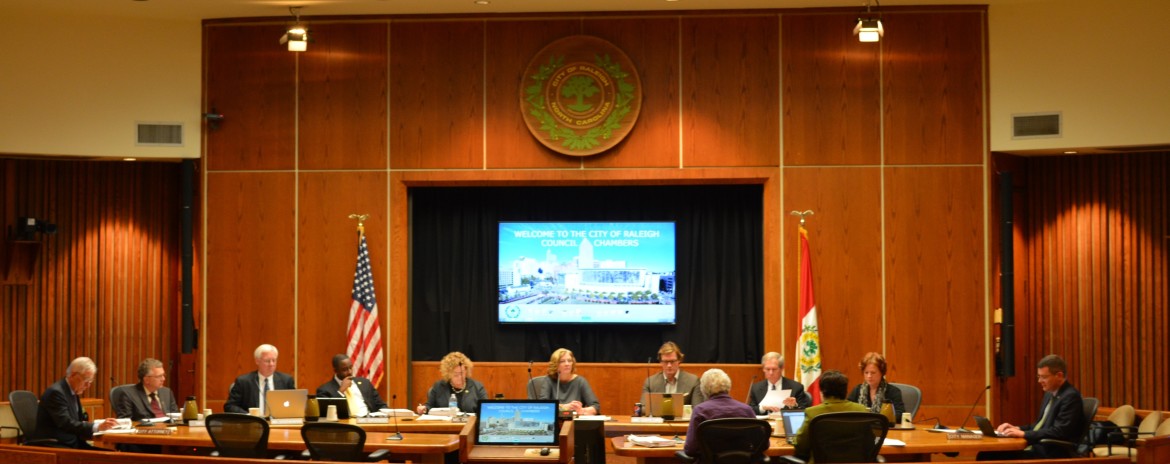Last week, we kicked off our 2016 City Council coverage with the return of the Council Agenda Preview, an in-depth look at the issues scheduled for discussion before council. Today, we’re unveiling the first edition of The Council Record, an informal but nevertheless comprehensive look at the most recent City Council meeting.
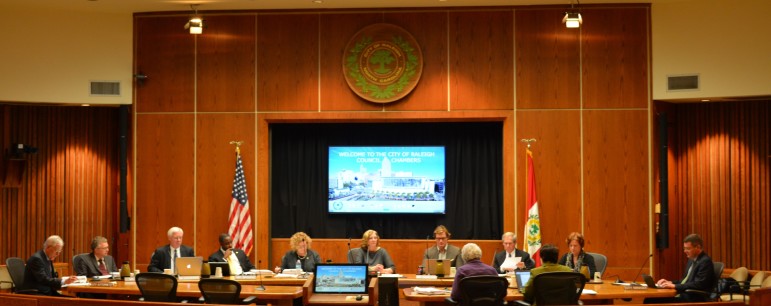
January 5, 2016
The first City Council meeting of 2016 kicked off in a fashion not dissimilar from its 2015 sessions: an invocation by the Reverend Paul Anderson, followed by the Pledge of Allegiance led by newly elected District B councilman David Cox.
Mayor McFarlane began the meeting by thanking staff for the newly installed video screens and presentation technology.
“We’ve upgraded from our rolling cart and overhead projector,” McFarlane observed.
“Thank you so much for bringing us into the new century.”
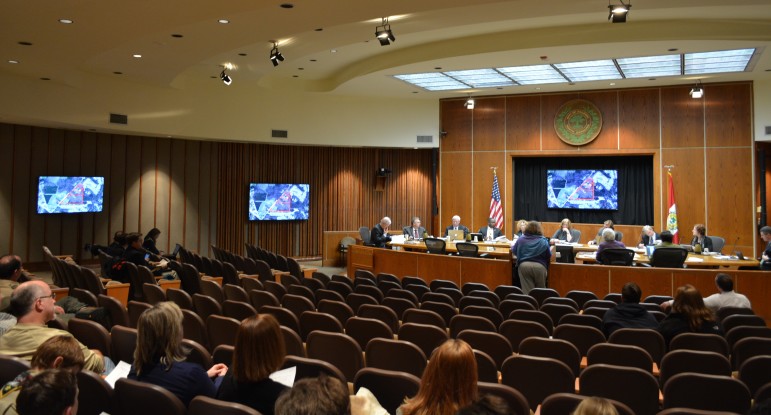
James Borden / Raleigh Public Record
The new screens on display in Council chambers
Presentations & Awards
Chris Heagarty of the City of Oaks Foundation was the first to address the council, who began by talking about a number of successful partnerships the organization had engaged in with the city, including a land transfer that led to the creation of a new park.
Heagarty’s main focus, however, was on the foundation’s Give Play program, which provides scholarships to city camps and outdoor nature programs for underprivileged youths. For more information on the program, you can check the Oak City Foundation’s website here.
Heagarty noted that the Give Play program had raised $27,000 in the previous year, and that this money was able to send 78 campers to 73 weeks worth of camp.
The presentation closed out with a video detailing the various benefits of the Give Play program, accompanied by upbeat music and plenty of footage of happy, diverse groups of children enjoying Raleigh’s parks and greenways.
McFarlane led a round of applause, thanking Heagarty for all the organization has done for the city.
Heagarty was followed by a presentation of awards for the 13th Annual National Arts Program, which features work by city employees and their relatives. Winners included artists from both of these categories, although “Glow,” the Best in Show Photography winner, was the work of a relative of an employee in the city attorney’s office.
For a gallery of the winners and more information about their work, you can visit the National Art Program’s website here. Or you can take an in-person gander at some of the artwork on the second story of Raleigh’s Municipal Building at 222 West Hargett, outside of the council chambers.
Consent Agenda
With one exception, the Council unanimously passed without discussion all of the items of the consent agenda, which we laid out in our Agenda Preview article last week.
The exception was a proposed change to the downtown hotel parking requirements, reducing it from the current one space per room to half a space or less per room.
As staff noted that “the parking requirement can be reduced by half or more without adverse impact,” councilor Mary-Ann Baldwin expressed interest in exploring further the “or more” portion of the analysis.
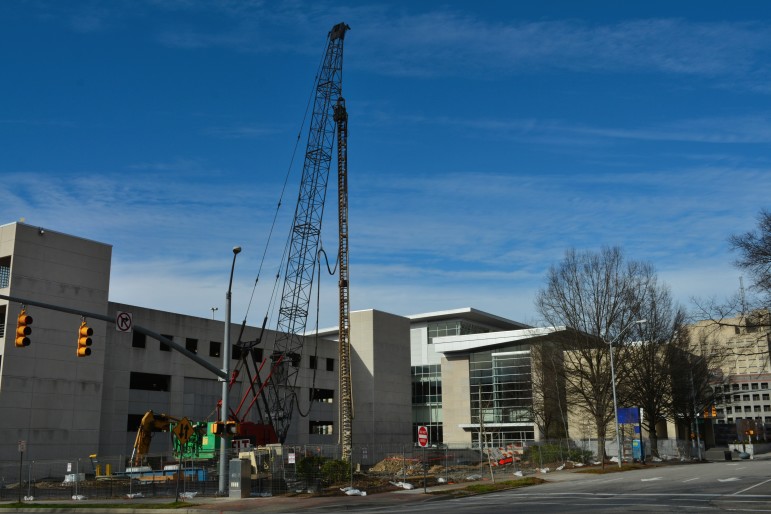
James Borden
Work is underway on a new Residence Inn hotel in downtown Raleigh
“Some cities don’t have any parking requirements” for hotels, Baldwin said.
“Why did we end up at half? I’m not saying we go to zero, but is there a number in between that might make more sense? Right now I’m looking at [the Convention Center parking deck] where there’s hundreds of spaces available.
“I would like further investigation.”
Councilor Bonner Gaylord said this might be an opportunity to reduce the downtown parking requirements for other building as well.
“For large projects, [the requirements are] more workable; for small or medium size projects, it can be problematic. While we’re looking at this reduction for the hotels, it may be a good time to look at some other property types.”
Councilor Russ Stephenson agreed, noting that because the process appeared to be staff investigation phase, it would be a good time to look at the requirements for other buildings as well.
City Manager Ruffin Hall noted that while there was a need to look at the parking requirements for other building types, hotels should take priority.
“One of the factors in bringing forward this discussion, we do have several hotel projects currently under discussion, so there’s some urgency to that from a timing perspective,” Hall said.
He requested that councilors send the parking requirements to planning commission for review, alongside a separate request to analyze the parking requirements for other building types. A motion was made to this effect and passed.
Special Items
The first two special items before council on Tuesday passed quickly and unanimously: the scheduling of a public hearing for January 19th for rezoning case Z-15-15, and the postponement of a vote on changes to the city’s dangerous dog ordinance to the January 19th meeting.
City Attorney Thomas McCormick said this extension would give members of the public additional time to comment on the changes.
The final special item dealt with a text change that would allow for the dissolution of former council committees and the creation of new ones. McCormick said the text change would not specify the names of the new committees, thus granting council the effective power of being able to change the committee structure without a formal text change process.
McCormick also discussed plans to put in place emergency contact procedures for each of the councilors, which, following the mayor and the mayor pro-tem, would be ranked by time served, and then alphabetically.
Report of the City Manager
The first item up was a loan modification request for the Downtown Housing Improvement Corporation that would help the company pay for repairs and reduce its current interest rate. We went into a little more detail in our agenda preview post, but if you want the full report on this and the other City Manager report items, check out this PDF from the agenda packet. Council voted to approve the loan modification.
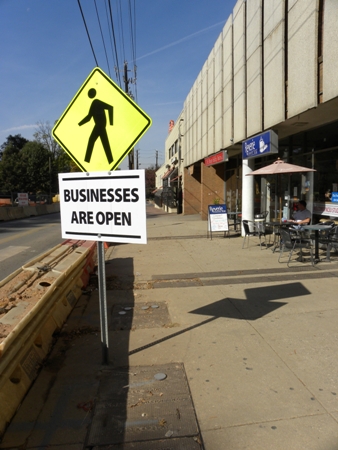
Hillsborough Street
The second report was on the city’s two municipal service districts, one downtown and the other along Hillsborough Street. The presentation was intended as purely an informational session, and council will provide feedback at the next meeting.
The presentation focused around the existing service providers for the MSDs, both of which have been in those positions since the districts’ inceptions. Due to new state laws, staff is working to evaluate how these service providers operate, and what the request for proposals process will be like when it comes time to signing new contracts. Again, this PDF has more details.
Next up was a lengthy presentation on the NC 540 Environmental Impact Statement. The city has a few concerns with several of the proposed routes for the expressway’s southeast extension project.
Among the issues presented by these routes were impacts on the water supply, on school property and a wastewater treatment plant. The mayor will send these comments to the North Carolina Department of Transportation.
Comprehensive Planning Committee Report
In the final report of the Comprehensive Planning Committee, Councilor Stephenson brought three issues before the council; the first was to pass several items out of his committee without comment, which was approved.
Next up was rezoning case Z-22-15, which the committee requested be resubmitted with a condition that the applicant would provide easement access to Creedmoor Road and pedestrian but vehicular access to Corberrie Lane, along with some tree preservation requirements.
Councilor Cox expressed some concerns over the case, saying that while a residential development with a cap of 36 homes would not have an adverse effect on traffic, the possibility of an office development has the potential to create headaches for surrounding neighbors.
The case was approved unanimously by council. As a result of Cox’s concerns, however, councilors also passed a motion stating that should the developer choose to build an office on the property, the city will not grant the easements required for access to the adjacent Brandon Station neighborhood. If the developer decides to build residential, the city would grant the necessary easements.
Next up was a pair of rezonings that the committee recommended denying: Z-34-15 and Z-35-15. They asked that the applicant come up with an alternative access to the property beyond Six Forks Road. Note: we initially had a picture below that was for Z-34-14, not Z-34-15. We apologize for the error.
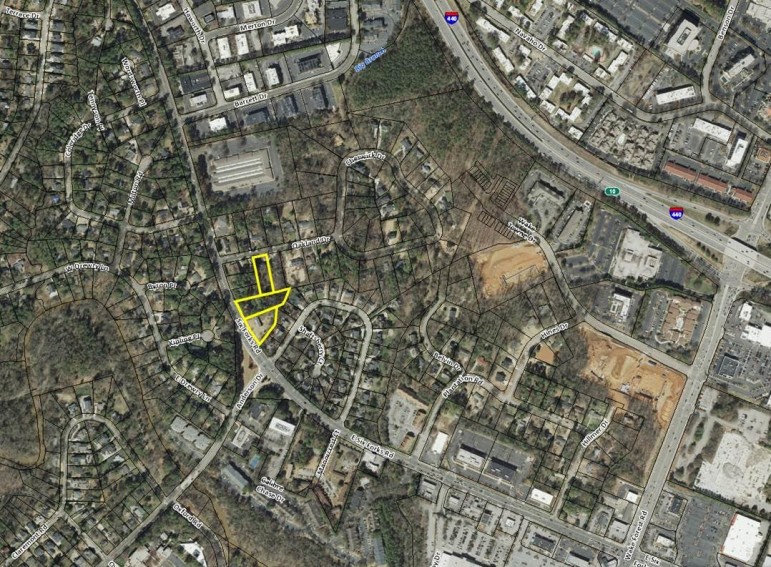
Google Maps
A map of Z-34 & Z-35-15
At Tuesday’s meeting, staff said the applicant had resubmitted plans that provided a public alleyway as an additional access point. This move didn’t satisfy the councilors, who voted unanimously to deny approval of the rezoning cases.
Individual Councilor Reports
Freshman councilor David Cox was the first to offer up his member report, which included a request for an update on the status of a dilapidated hotel on Capital Boulevard and a request to change the requirements for citizen presentations on the new, recently installed system that McFarlane had praised at the beginning of the meeting. The hotel is the former Capital Plaza, located at 2815 Capital Boulevard.
When it comes to public presentations to council, as it currently stands, citizens have to turn in their presentations to staff the Thursday before a Tuesday meeting. When he was a citizen making presentations to council, Cox noted, he was frequently “in the audience, still working on my presentation.”
McFarlane noted that this would be a good topic of discussion for the council’s planned retreat beginning January 14 in Charlotte.
Councilor Baldwin in her report sung the praises of the Regional Transportation Alliance conference she attended in December with Councilors Gaylord and Branch. Baldwin was particularly inspired by one of the speakers, Gabe Klein, who co-authored the book “Start-Up City.” Baldwin came bearing gifts in the form a copy of the book for each of the Councilors. She said it dealt with a lot of the issues Raleigh is facing right now, such as bike sharing, citizen engagement and attracting innovation, and that the book would be a good subject for discussion at the council retreat.
In his report, Councilor Stephenson noted that councilors should also discuss at their retreat the possibility of video taping their work sessions. He described the work sessions as “an excellent format where complex topics that are not brought directly to council for a vote, we get a week out for a work session to mull it over, ask questions. It’s a great opportunity for councilors to get up to speed, and by that same token it should be a great opportunity for citizens.”
We’re not in the habit of coming out in favor of or against any given city policy, but having access to videos of the council’s work sessions would be a benefit not only to citizens, but to the citizen journalists of the Record as well.
Evening Session
Although Record editor James Borden live-tweeted the council’s evening session last week, he didn’t find much to comment on, and the most popular tweets of the night focused around the ever-growing number of empty seats and the bored looks in nearly everyone’s eyes.
As such, we can’t really offer that up as official coverage.
The evening session began, as usual, with citizen petitions. Citizens have a set time to present their issue to council, which usually does not offer a direct response. Here were the issues addressed at the meeting; although the list is in the order it appeared on the agenda, one of the speakers, for item number five, was late and presented later in the evening. But that’s not really important.
- Joey Stansbury discussed the process for appointment of Raleigh citizens to vacant City Council seats. At present, there is not a formal process on choosing a successor should a council member suddenly have to vacate their seat.
- Jeremiah Frederick discussed a sewer pipe which he alleged is a hazard to his lifestyle and in the way remodeling property at 1109 Marks Street. NOTE: Councilors responded to this issue and noted that the sewer pipe is not city property.
- David Simonton, 1218 Lorimer Road addressed what he sees as a problematical discrepancy in two closely related City sidewalk petition processes. He said the current process can cause acrimony and create divides within neighborhoods looking to add sidewalks.
- Tony Coates, representing the Donald Lewis Coates Estate, discussed the impact of the Hillsborough Street Revitalization Phase II project. He said the estate’s property, Campus Auto Rep, was going to be torn down by the city as part of their revilitization plan. Coates argued that the this phase II portion of the plan was unnecessary.
- Larry Booth requested Council relocate the Duke Energy Transformer bunker proposed at 3111 Hillsborough Street and relocate the temporary construction easement to help save the oak tree at 3109 Hillsborough Street.
- Kieran Shanahan and Jim White, Shanahan Law Group, would like to request a text change to the UDO to provide a process to approve the location of fences within a tree conservation area. White was representing people from Oakwood North who had installed fences which were in violation of the tree conservation ordinances.
Next up was a public hearing on the city’s 2016-2017 annual budget. The only request was a path near Trenton Road that was funded by a bond referendum begin construction as soon as possible. The only comment came from the director of Guiding Lights, a local nonprofit which did not receive city funding this year and subsequently had to cancel a nurse training program that graduated 34 last year.
Councilor Baldwin inquired into why the organization had been denied funding, and it turned out that a change in state law had created some accounting and management issues within the nonprofit and that when the time came around to apply for city of Raleigh funding, they had not completely spent the money from the previous year’s grant, although that money has subsequently been spent.
Two District E petition annexations were approved without comment or dissent, but a public hearing on a rezoning case triggered a long discussion about the potential need for a traffic study.
Case Z-38-15 is a request to rezone 22.9 acre property on Shady Grove Road at the intersection with Leesville Road from Residential Rural with Airport Overlay 60- 65 LDN to Residential-6 Conditional Use. The Planning Commission has recommended this item for approval, and the Northwest Citizens Advisory Council voted in favor as well.
Councilor Gaylord noted that several constituents had brought up traffic concerns in relation to the project, and asked whether the developer would be able to do a traffic study. Such a study, developer Philip Layton argued, would be “overkill.”
Layton proposed a 57-home cap (perhaps he is a fan of either Heinz Ketchup or Senator Joseph McCarthy) for the development, which would minimize nearly all traffic concerns.
Councilors agreed to close the public hearing, and Layton will add the 57-home cap condition to the project before bringing it back to Council for approval.
